Manotick Homes: Prevent Summer Erosion on Clay Slopes
Quick Erosion Prevention Guide:
- Understand how Ottawa's clay soil and summer rain patterns contribute to erosion on slopes.
- Identify early warning signs like bare spots, exposed roots, and mini-channels (rills).
- Utilize plants (groundcovers, shrubs) with strong root systems to bind soil.
- Consider structural solutions like retaining walls or terracing for steeper slopes.
- Apply organic mulch to protect the soil surface and improve moisture retention.
- Manage water runoff with proper downspout direction and potential drainage solutions like swales.
Need help implementing these solutions? Request a free quote today!
Introduction: Hey Manotick! Let's Talk About That Slippery Slope (Literally!)
Hey there, Manotick! We love our beautiful village, but sometimes our yards present… challenges. Let's talk about that literal *slippery slope* you might have on your property – you know the one! We're tackling summer erosion, especially common on the clay slopes we see throughout the Ottawa area, from here in Manotick and Kars over to Greely.
So, what exactly is summer erosion on these slopes? When heavy summer rain hits, especially after a dry spell, the water doesn't always soak in quickly on clay soil. Instead, it runs downhill, carrying away valuable topsoil, potentially messing up your carefully planned garden beds, and making walkways slick. It's more than just a muddy nuisance; it can seriously impact your landscaping efforts and the overall health of your yard.
But don't start worrying about sliding away just yet! The good news is there are effective solutions. This article is packed with practical tips and *landscaping* ideas specifically for dealing with sloped yards in our area. We’ll explore smart *planting* strategies using things like hardy *groundcover* and deep-rooted *shrubs*, discuss improving *drainage*, and look at other ways to stabilize your slope and keep your soil right where you want it. Let's dig in!
Why Your Manotick Yard Might Be Doing the Mudslide: Understanding Clay Slopes & Ottawa Summers
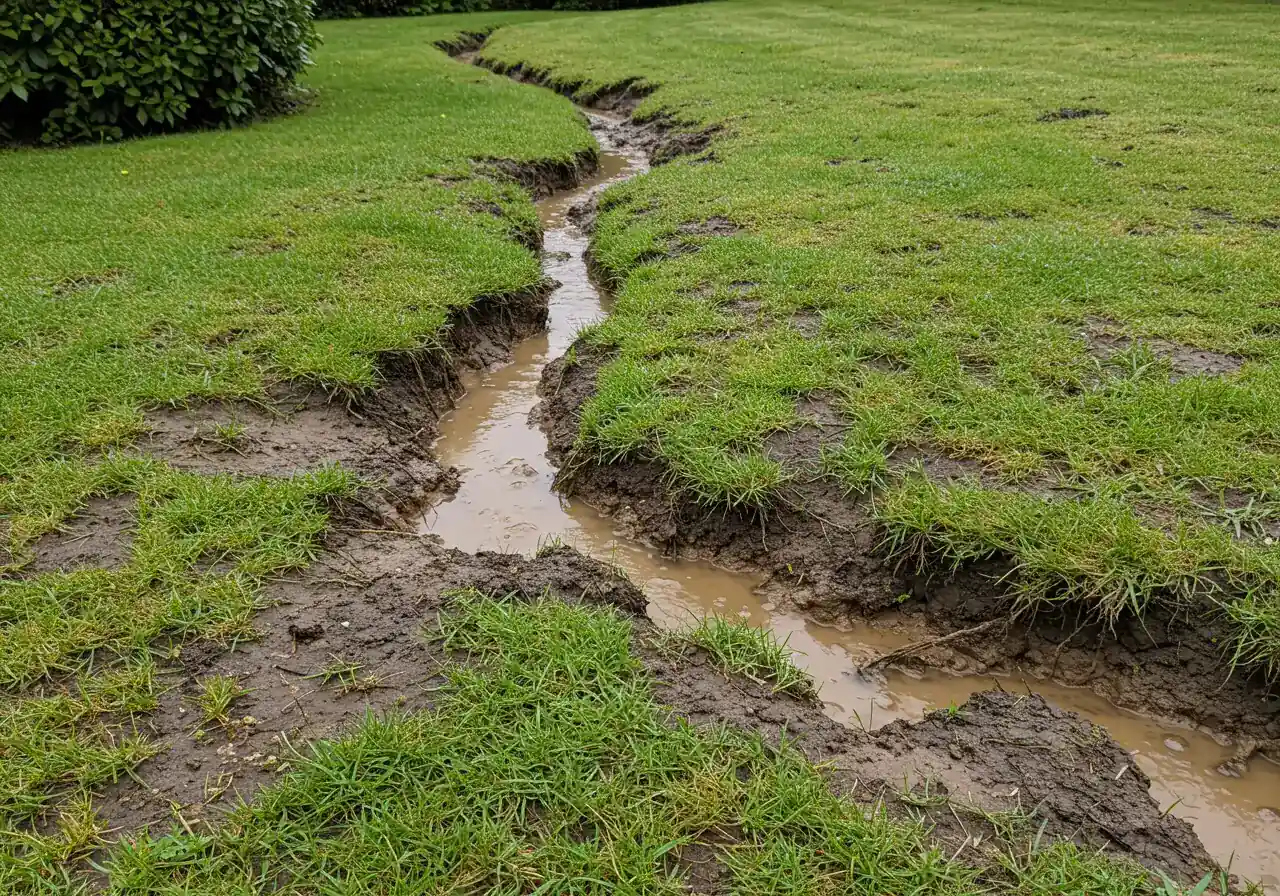
Okay, so your Manotick yard seems to have aspirations of becoming a water park slide every time it rains heavily? You step outside after a downpour, and *whoosh* – bits of your lawn or garden beds look like they're trying to escape downhill. If this sounds familiar, you're definitely not alone! Many homeowners in our beautiful slice of Ottawa, including neighbours in nearby Greely and Osgoode, wrestle with this very issue, especially if their property has even a gentle *slope*. The dynamic duo responsible for this muddy situation? Our region's prevalent clay soil and the classic Ottawa summer weather pattern.
Let's talk about clay soil first. Think of it like tightly packed plasticine or super dense, fine powder. Unlike sandy soil where water can easily trickle through the larger gaps between particles, clay particles are tiny and stick together. When clay gets wet, it holds onto water tenaciously, often becoming heavy and slick. When it dries out during those hot, rain-free stretches we often get in July and August, it can bake hard, sometimes even cracking on the surface. Proper soil preparation can help improve its structure over time.
Now, picture what happens during a typical Ottawa summer storm: days or weeks of dry heat, followed by a sudden, intense downpour. That hard-baked clay surface acts almost like a paved driveway – it can't absorb a large volume of water quickly. So, instead of soaking *in*, the rainwater starts running *off*, creating surface runoff.
Add a *slope* to this equation, and gravity kicks in, giving that runoff speed and power. As the water rushes downhill, it easily picks up loose particles of soil – especially the valuable *topsoil* needed for healthy gardening and lawn growth. This process is *erosion*, and it's why you might see rivulets cutting through your lawn or mulch washing away from your flower beds. The steeper the *slope*, the faster the water flows, and the more soil it can potentially carry away.
Managing this water flow is crucial. Even how you water your lawn can play a part; ensuring systems aren't adding to the saturation problem is why performing regular Manotick irrigation checks can save water and headaches this summer. Smart *landscaping* choices, such as incorporating specific *planting* techniques or structures, can significantly reduce erosion. Sometimes, a fresh perspective on layout is needed, making resources on Manotick garden design and creating your dream backyard quite valuable. Consistent yard care throughout the year also builds resilience; preparing your soil and plants properly each fall, as outlined in guides like the Manotick Fall Cleanup & Winter Lawn Prep Essentials and the more detailed Manotick Fall Cleanup & Winter Prep Guide, contributes to better soil structure over time. Understanding these factors is the first step, but if implementing solutions feels daunting, professional Landscaping & Yard Care Services are always available to help design and build effective erosion control for your property.
Spotting Trouble Before it Starts: Early Warning Signs of Erosion
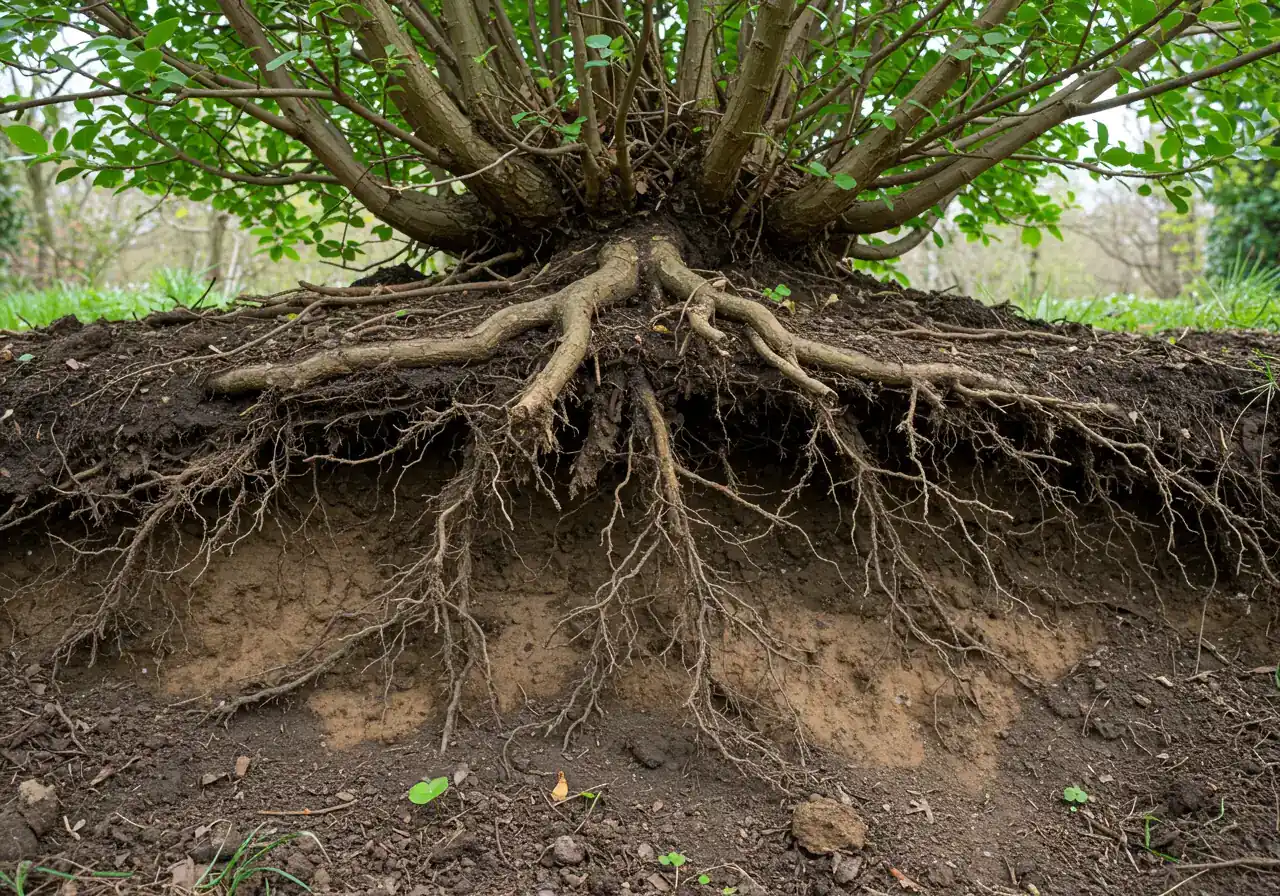
Alright, let's talk about playing detective in your own backyard! Erosion doesn't usually send a formal invitation before it starts messing with your *landscaping*. It’s more like that sneaky squirrel burying nuts *everywhere* – it happens gradually, often unnoticed until suddenly, you realize your favourite *groundcover* patch looks a bit… sparse. Especially here in the Ottawa region, from Manotick right over to Barrhaven, those heavy summer rains on our clay slopes can kickstart erosion without much fanfare. Catching it early is the secret weapon to preventing bigger problems.
So, what sneaky clues should you be watching for? Keep your eyes peeled for these early warning signs, particularly after a significant downpour:
- Bald Spots Appearing: Notice patches of bare soil popping up where healthy grass or *plants* used to thrive? This is often ground zero, where runoff starts gaining momentum. Weak or patchy turf is more vulnerable, which highlights the importance of consistent expert lawn care solutions to maintain dense, healthy grass with strong roots.
- Mud Splatter Evidence: Check the base of fences, retaining walls, downspouts, or even the lower leaves of your *shrubs*. Little splashes of mud indicate that soil-laden water is hitting those surfaces as it flows downhill.
- Mini-Riverbeds (Rills): After rain, look for small, defined channels or grooves carved into the soil surface. These tiny rivulets show the pathways water is taking and where it's actively removing soil.
- Suddenly Exposed Roots: Are the roots of your trees, *shrubs*, or even sturdy perennials becoming visible when they used to be underground? That’s a classic sign that the surrounding topsoil is washing away.
- Debris Piles at the Bottom: Is mulch, soil, gravel, or other *gardening* debris accumulating at the base of the slope, perhaps against a curb or walkway? This shows that material from upslope is eroding and being deposited lower down. Dealing with this shifting debris can sometimes feel like a constant battle, which is where services like our Manotick Yard Cleanup Service can lend a hand, keeping those lower areas tidy. You might also find similar challenges requiring Ottawa yard cleanup service or even more specific city yard cleanup service depending on your location.
- Water Running Brown: If you actually see visibly muddy or cloudy water flowing off your slope during or right after rain, that’s your precious topsoil making a swift exit!
Your Post-Rain Inspection Routine:
Think of this as a quick health check for your slope. After the next good soaking rain (and once it's safe to walk around):
- Take a Stroll: Carefully walk your sloped areas. Look down the slope for those tell-tale channels (rills) and look up the slope for any new bare spots.
- Check the Low Points: Investigate the bottom of the slope and any areas where water naturally exits your property. Is there a fresh build-up of soil, mulch, or other debris?
- Inspect Plant Bases: Get a closer look around your *plants*. Are roots showing? Is there mud splashed high on the stems?
- Examine the Edges: Look along walkways, patios, driveways, and garden bed borders. Is soil spilling over onto hard surfaces or washing out from under edging?
Spotting one or two minor signs might just require a small tweak in your *planting* or *drainage*. But if you're noticing several of these warning signs consistently, it’s a signal that your slope needs a bit more attention to prevent the problem from worsening. Ignoring persistent erosion can lead to significant soil loss, damaged *landscaping*, and even foundation issues down the line.
If you're seeing these signs and feeling a bit overwhelmed about what to do next, or wondering about potential solutions and costs, don't hesitate to reach out for professional advice. We value clear communication and your input, which is why we even have a page dedicated to Estimate Feedback to ensure we're meeting your expectations. When you do contact us, please know your personal information is handled responsibly, as outlined in our Privacy Policy. Tackling erosion effectively often involves a combination of strategies, and you can explore the various ways we can help on our main Landscaping & Yard Care Services page. Acting early is always the best bet!
Comparing Erosion Control Methods
Using Plants for Stability
Planting is often the most natural and cost-effective method for moderate slopes. Key strategies include:
- Groundcovers: Fast-spreading plants like Sedum or Creeping Thyme cover bare soil quickly.
- Shrubs: Varieties like Potentilla or native Dogwoods offer deeper root systems for better anchoring.
- Root Systems: Plants create a network of roots that physically bind soil particles together.
- Surface Cover: Leaves and stems intercept rain and slow surface water flow.
Explore our garden installation services for professional planting assistance.
Structural Support
For steeper slopes or areas needing level ground, hardscaping provides robust solutions:
- Retaining Walls: Physically hold back soil, creating level tiers. Requires careful construction and potentially permits. See our transformations gallery for examples.
- Terracing: Creates a series of flat steps down the slope, dramatically slowing water and providing planting areas.
- Swales & Drains: Engineered channels (swales) or underground pipes (French drains) redirect water flow safely away from vulnerable areas.
Proper material selection is crucial for longevity.
Ongoing Care for Slopes
Maintaining your slope solution ensures long-term effectiveness:
- Mulching: Regularly applying organic mulch protects soil, retains moisture, and reduces splash erosion. We offer mulching and edging services.
- Water Management: Direct downspouts away from slopes and water plants deeply but infrequently once established.
- Regular Inspection: Check for signs of new erosion after heavy rains, especially during spring and fall cleanup (Property Clean Up).
- Weeding: Remove weeds gently by hand to avoid disturbing established plants and soil.
Fighting Back with Flora: Plant Power for Slope Stability
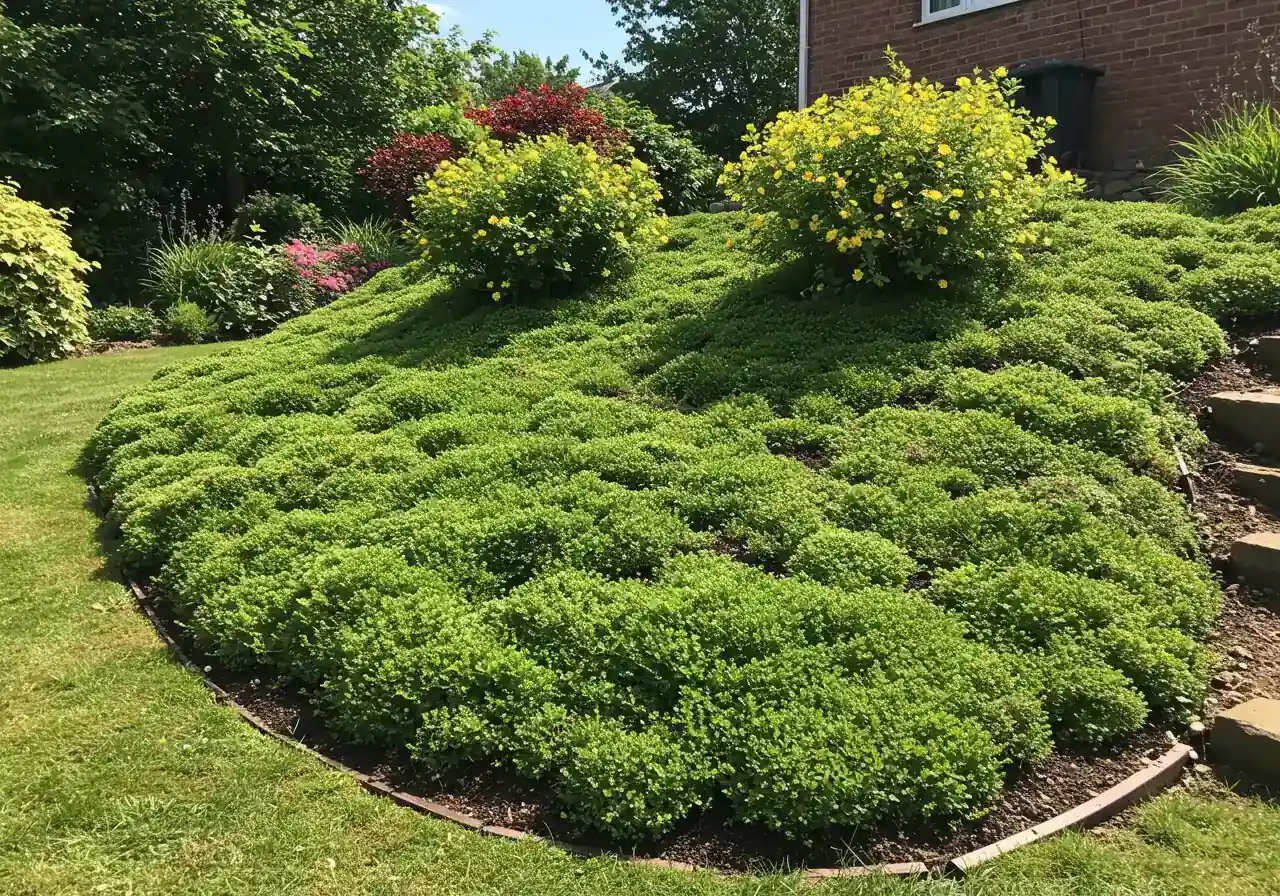
Okay, so we've established that your slope might have ambitions of becoming a muddy slip 'n slide. But fear not! Nature has provided us with some fantastic, living tools to fight back: plants! Using the right greenery isn't just about making your slope look pretty (though that’s a bonus!); it’s one of the most effective and eco-friendly ways to stabilize soil and stop erosion in its tracks. Think of it as giving your slope a super-strong, all-natural hairnet.
How does this plant power work? It's a two-pronged attack:
- Root Warriors: Below ground, the roots of plants spread out, creating a dense, fibrous network. This network acts like rebar in concrete, literally binding the soil particles together and holding them in place. The deeper and more extensive the root system, the better the stabilization.
- Canopy Crusaders: Above ground, the leaves and stems form a canopy. This canopy intercepts raindrops *before* they hammer directly onto the soil surface, softening their impact and reducing splash erosion. Plants also slow down the flow of water running across the surface, giving it more time to soak in rather than rushing downhill carrying your precious *topsoil* with it.
Choosing Your Plant Army for Ottawa Slopes
Not just any plant will do for the challenging conditions of a clay slope in our Ottawa climate (Zone 5a/b). We need tough cookies that can handle clay soil, potential dry spells, and our winter cold. Here are some categories and examples that often perform well:
- Groundcovers: These low-growing spreaders are excellent for covering bare soil quickly. Their dense mats protect the surface, and their roots provide shallow stabilization.
- Examples: Creeping Thyme (drought tolerant, fragrant), Sedum (many varieties, very tough), Vinca minor/Periwinkle (vigorous, shade tolerant - *use cautiously as it can be invasive*), Bearberry (*Arctostaphylos uva-ursi* - a great native choice!).
- Shrubs: Offering more structure and deeper roots than groundcovers, shrubs are slope stabilization workhorses. Choose varieties known for fibrous or spreading root systems.
- Examples: Sumac (especially Staghorn Sumac - *native, spreads readily, great fall colour*), Potentilla (long blooming, very hardy), Shrubby Cinquefoil (*Dasiphora fruticosa* - native), Red Osier Dogwood (*Cornus sericea* - native, loves moisture but adaptable, great winter interest). Check out Ontario Native Plant Guides for more local options.
- Small Trees: Best used sparingly on slopes (don't want too much weight!), small, deep-rooted trees can provide excellent anchoring, especially when integrated with shrubs and groundcovers.
- Examples: Serviceberry (*Amelanchier canadensis* - native, multi-season interest), Hawthorn (*Crataegus* species - tough, often thorny, good wildlife value).
Quick Comparison:
| Plant Type | Root System Style | Coverage Speed | Primary Role |
|---|---|---|---|
| Groundcover | Shallow, Spreading | Fast | Surface Protection |
| Shrub | Deeper, Often Fibrous | Medium | Mid-Level Anchoring |
| Small Tree | Deepest | Slow | Deep Anchoring |
Planting for Success
Just chucking plants at the slope won't cut it! Proper technique is key:
- Dig Wide, Not Just Deep: Give roots room to spread outwards into the surrounding clay.
- Soil Prep Matters: While plants need to adapt, slightly amending the backfill soil with compost can help them get established. Focus on creating good conditions right around the root ball. Ensuring proper soil preparation gives your new plant pals the best possible start.
- Mulch is Your Friend: Apply a layer of wood chip or bark mulch (not rock on steep slopes, it can slide!) to retain moisture, suppress weeds, and provide initial surface protection.
- Water Wisely: Water deeply but less frequently once established to encourage deep root growth.
Consider seeking out native species whenever possible. You can find many suitable plants at local garden centres around Ottawa, including those serving the Barrhaven and Nepean areas. Native plants are adapted to our conditions, require less fuss, and support local pollinators and wildlife! Resources like the Rideau Valley Conservation Authority (RVCA) often have helpful planting information.
While these plants are tough, establishing them still requires care. Once they take hold, they often need less intensive work than traditional beds, but some consistent garden maintenance like weeding and occasional pruning keeps things looking sharp and functioning well. Trying to maintain lawn on a very steep slope can be difficult and sometimes dangerous, making groundcovers and shrubs a safer alternative to needing tricky expert lawn care solutions in those spots. If you're clearing an area previously neglected or covered in debris before planting, services like our Metcalfe property cleanup service can handle the heavy lifting and disposal, creating a clean slate for your planting project. Our teams cover a wide area, including Marionville property cleanup service.
Feeling inspired but maybe a bit overwhelmed choosing the perfect plants or tackling the installation? We get it! We're happy to help you select the right flora for your fight against erosion. Feel free to contact us or request service, and let’s get your slope stabilized and looking great!
Erosion Risk vs. Slope Gradient (Illustrative)
Steeper slopes generally experience faster water runoff and higher erosion potential.
Structural Solutions: Hardscaping and Smart Drainage
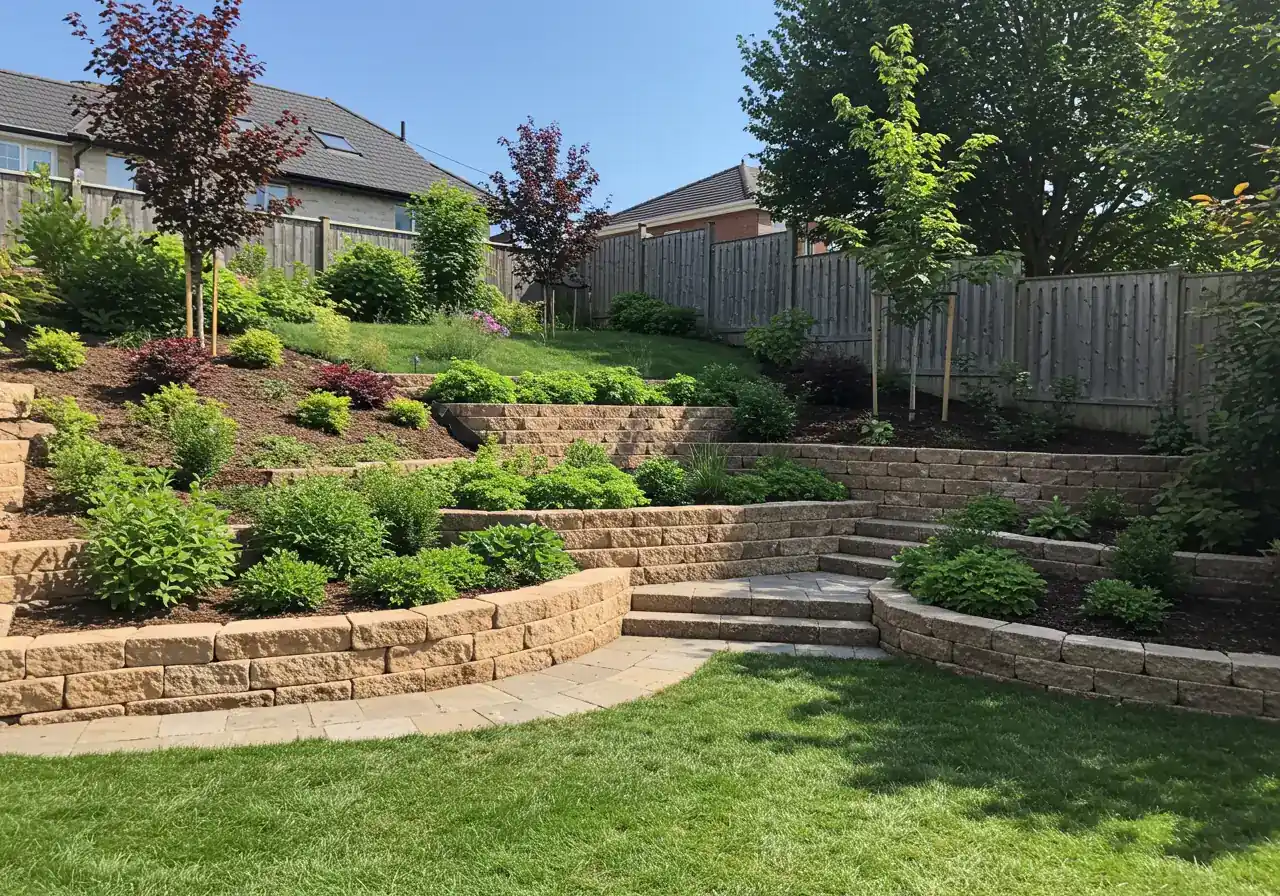
Okay, so we've talked about using plants as your slope superheroes. But sometimes, especially if your yard in Richmond or Metcalfe looks more like a ski hill than a gentle incline, plants need some serious backup! When *erosion* is playing rough, or you simply want to reclaim some usable flat space on that hillside, it’s time to consider the heavy hitters: structural solutions using *hardscaping* and smarter ways to handle water flow with clever *drainage*. Don't worry, it's not as complicated as it might sound, and the results can be fantastic!
Think of *hardscaping* as building the strong bones for your slope solution. These are permanent structures designed to physically manage soil and grade changes:
- Retaining Walls: These are exactly what they sound like – sturdy walls built to hold back soil. If you have a noticeable drop-off, or you dream of carving out a level patio, pathway, or garden bed on your slope, a retaining wall is often the best bet. They literally *retain* the soil behind them, preventing it from sliding downhill. Choosing the right look and ensuring it's strong enough involves careful Material Selection, with options ranging from natural stone for a rustic look to pre-cast concrete blocks for uniformity and ease of installation.
- Terracing: Imagine transforming your challenging slope into a series of wide steps or flat platforms. That's terracing! Each "terrace" creates a level area, which dramatically slows down water runoff as it hops from one level to the next. This gives water more time to soak in and provides wonderful, accessible pockets for *planting*. It effectively breaks one long, erosion-prone slope into several shorter, more stable ones.
Heads Up! Building significant retaining walls (often anything over 1 metre or about 3.3 feet high in Ottawa) usually requires professional engineering plans and city permits. Because they hold back a lot of weight, proper design and construction are crucial for safety and longevity – definitely not a casual weekend project if it’s a tall one! Check the City of Ottawa Building Permit requirements for details.
While walls hold back the earth, smart *drainage* techniques focus on managing the *water* itself – the main culprit behind *erosion*.
- Swales: Think of these as gentle, often grassy, shallow channels or wide depressions built across the slope. Their job is to catch surface runoff and guide it slowly sideways, rather than letting it rush straight down. This slow journey allows much of the water to soak harmlessly into the ground. Swales can be subtle landscape features, sometimes planted with attractive moisture-tolerant grasses or perennials.
- French Drains: Are persistent soggy spots making you crazy, maybe near your foundation or at the bottom of the slope? A French drain could be your underground hero. It’s basically a hidden trench lined with landscape fabric, filled with gravel, and containing a perforated pipe. It collects excess surface and groundwater and discreetly channels it away to a suitable outlet, like a storm drain or a dry well, keeping areas dry.
- Rain Gardens: These are specially designed, shallow depressions planted with beautiful, water-loving flowers and grasses. Often located where a downspout discharges or at the end of a swale, they act like natural sponges. They collect rainwater runoff, filter it through the soil and plant roots, and allow it to slowly soak into the ground, reducing runoff volume and helping recharge groundwater. Plus, they look great and attract pollinators! Learn more about Rain Gardens here.
Often, the most effective *landscaping* plan combines these strategies – perhaps a low retaining wall at the base of a slope, with terraced beds above, and a swale diverting water towards a rain garden. Getting these structures designed and built correctly is key to ensuring they function properly and last for years. If your slope seems particularly tricky, or if the project involves significant earth moving and construction, getting professional advice is definitely a smart move. We can help evaluate your site and recommend the best solutions. Feel free to Contact Us to discuss your project. We also value our reputation; check out our reviews on Google!
Undertaking these kinds of structural improvements often means preparing the site first or dealing with cleanup afterwards. Whether you need help clearing out stubborn brush and debris before the work begins, perhaps requiring our dedicated Metcalfe property cleanup service if you're in that area, or need general site restoration and removal of leftover soil or construction materials anywhere in Ottawa after the job is done, efficient Property Clean Up is key to the finishing touch. Our teams handle jobs big and small, and as our work providing the Marionville property cleanup service shows, we cover a wide service area in and around the city. Our Ottawa property cleanup service covers broader needs. Let the pros handle the heavy lifting and the tricky installations!
Typical Slope Stabilization Project Timeline
Step 1: Consultation & Assessment
We visit your property, assess the slope, discuss your goals, and identify erosion issues. We consider soil type, grade, drainage, and existing landscaping.
Step 2: Design & Proposal
Based on the assessment, we design a tailored solution (planting, hardscaping, drainage, or a combination) and provide a detailed proposal outlining the work and costs.
Step 3: Site Preparation
This may involve clearing vegetation, grading, removing debris (City property cleanup service might be relevant for adjacent areas), and marking out structures or planting zones.
Step 4: Implementation
Construction of walls/terraces, installation of drainage systems, or planting of selected species begins, following the approved design.
Step 5: Finishing Touches & Cleanup
Includes adding mulch (mulching and edging), final grading, site cleanup, and providing care instructions for new plantings.
Sustainable Slope Care: Mulch, Maintenance & Mother Nature
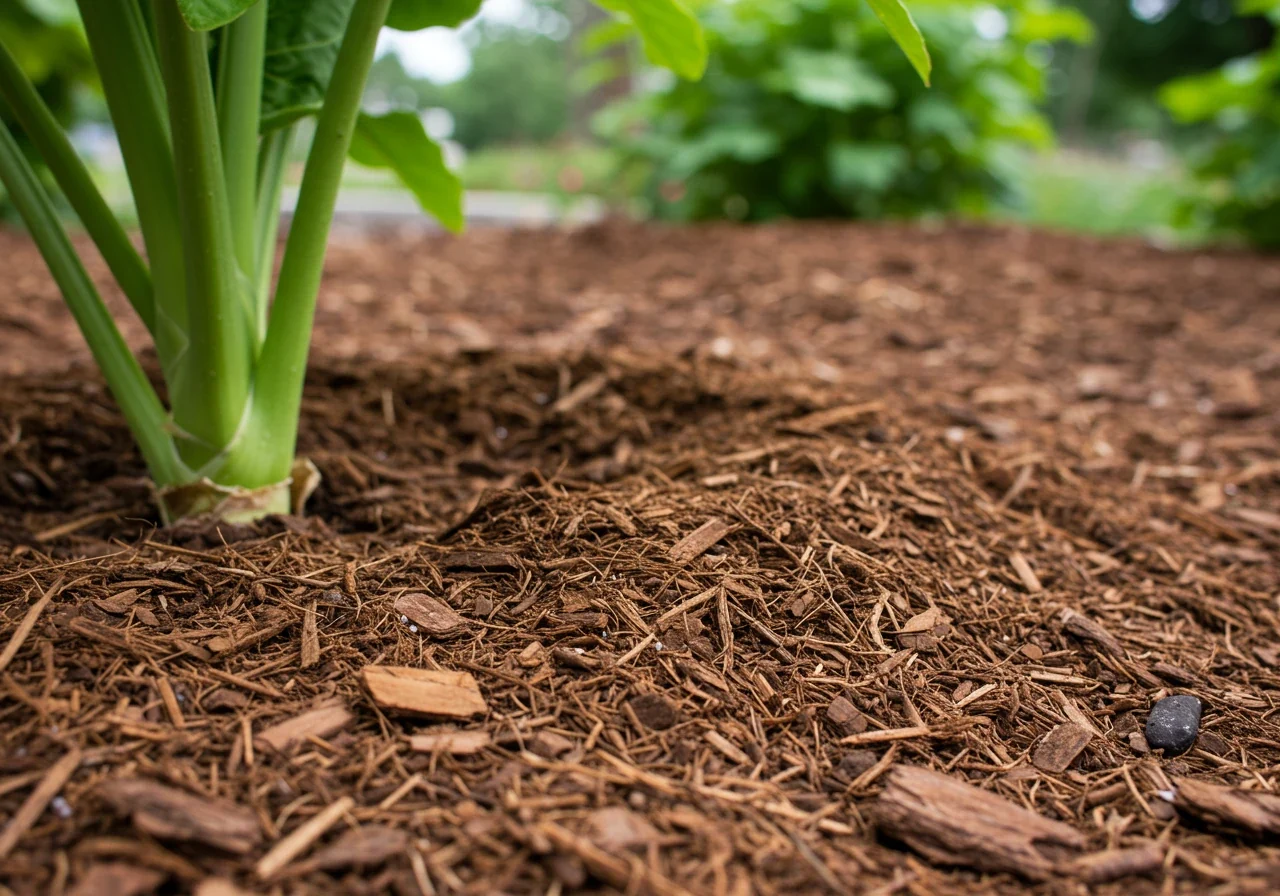
Alright, you've planted your slope warriors or installed some clever hardscaping – high five! But holding back that enthusiastic soil isn't usually a "set it and forget it" deal. Think of it like this: you wouldn't expect a great haircut to stay perfect forever without a little upkeep, right? Same goes for your slope! Sustainable slope care is all about working *with* nature, using smart maintenance tricks, and keeping things happy long-term. The good news? It's often less work than constantly battling washouts, and much kinder to the environment.
Mulch: More Than Just Pretty Dressing
We mentioned mulch briefly before, but let's really sing its praises! A good layer of organic mulch (like shredded bark or wood chips – skip the slippery rocks on steep slopes!) is like Mother Nature's favourite blanket. Here’s why it’s awesome for your slope:
- Acts like Armor: Mulch shields the soil surface from the direct impact of raindrops, reducing that initial splash erosion.
- Slows the Flow: It creates a rougher surface, slowing down water runoff and giving it more time to soak in.
- Keeps Soil Moist & Cool: Helps retain water during dry spells (looking at you, Ottawa summers!) and buffers soil temperature extremes.
- Builds Healthy Soil: As organic mulch breaks down, it adds valuable organic matter, improving soil structure over time – especially helpful for our clay!
Applying mulch properly is key. You want a layer about 2-3 inches deep, keeping it slightly away from plant stems. Need a hand getting that perfect layer down and keeping the edges tidy? Our expert Mulching and Edging services ensure it's done right for maximum benefit and curb appeal.
Compost & Blankets: Giving Nature a Nudge
While mulch protects the surface, incorporating compost into the soil *before* planting or when topping up beds gives your soil a long-term boost. Compost improves drainage in heavy clay and helps sandy soil hold more water – basically, it makes your soil behave better!
For newly seeded areas or particularly vulnerable spots while your plants get established, *erosion control blankets* can be lifesavers. These are typically biodegradable mats made of straw or coconut fibre held together by netting. They hold soil and seed in place, slow water down, and gradually decompose as your plants take over. Think of them as temporary training wheels for your slope's vegetation. While establishing grass on very gentle slopes might be an option, requiring careful prep similar to professional Sod Installation, steeper areas often benefit more from these blankets combined with specific erosion-control plantings.
Simple Water Smarts
- Downspout Direction: Make sure your roof downspouts aren't dumping water directly onto the slope. Extend them to guide water gently away to a stable area or drainage system.
- Water Wisely: Once plants are established, water deeply but less frequently to encourage strong, deep roots. Avoid frequent shallow watering, which encourages shallow roots vulnerable to drying out and erosion.
A Quick Seasonal Checklist (Ottawa Style!)
- Spring: Gently rake off any heavy debris left by winter. Check for erosion spots or mulch that's washed away. Top up mulch where needed. This is a great time for a general tidy-up; our Ottawa Yard Cleanup Service can get your whole property, slopes included, ready for the growing season. Service may also extend to areas covered by Metcalfe yard cleanup service or Marionville yard cleanup service.
- Summer: Keep an eye out for erosion after heavy rains. Pull weeds *gently* by hand to avoid disturbing the soil more than necessary. Ensure plants are getting enough water during dry spells. Regular city garden maintenance service can help manage this.
- Fall: Clear fallen leaves and debris, especially from drainage paths. Apply a final layer of mulch if needed to protect soil over winter. Consider a thorough fall cleanup to prevent debris from causing drainage issues or smothering plants; comprehensive Property Clean Up prepares your slope for the snow.
Why Bother? The Bigger Picture
These simple, sustainable practices do more than just keep your Manotick or Kars yard looking sharp. Healthy, stable slopes mean less soil and fertilizer washing away. That sediment and nutrient runoff can cloud waterways and contribute to algae blooms in places like our beautiful Rideau River. By managing your slope responsibly, you're helping protect local water quality. It's about being a good land steward (check our About Us page to learn our philosophy) and preventing issues that might otherwise contribute to the need for larger interventions, even impacting shared spaces managed by the City Property Cleanup Service. It’s neighbourly *and* nature-friendly! Always ensure you understand service details by reviewing the Terms and Conditions.
Quick Tips for a Stable Slope
Got a slope in your Ottawa yard trying to pull a fast one every time it rains? We hear you! Keeping that hillside happy, especially on our lovely clay soil, doesn't require advanced geo-engineering degrees (phew!). Whether you're wrestling with a gentle grade in Nepean or a steeper challenge elsewhere, try these quick tips to encourage your soil to stay put:
- Plant Power Up! Don't leave soil naked and afraid! Cover bare ground with hardy *groundcovers* (like Sedum or Creeping Thyme) or deep-rooted native *shrubs*. Their roots weave a natural net underground, holding everything together. Getting the area ready might involve clearing weeds or old debris, a task similar to what's covered by our specialized Metcalfe Garden Clean Up Service or Marionville garden clean up service when prepping garden beds.
- Mulch Like You Mean It. A 2-3 inch layer of organic mulch (wood chips or shredded bark work wonders) is your slope's best friend. It softens raindrop impact, slows water flow, and helps moisture soak in. Keeping the area clear *before* mulching ensures the best contact; tackling accumulated leaves and debris is often part of a thorough Metcalfe Yard Cleanup Service.
- Direct That Downpour. Check where your roof downspouts empty. Make sure they aren't blasting water directly onto the slope! Extend them to guide water gently towards a flatter, more stable area or a proper *drainage* system. Keeping these pathways clear is essential for preventing water backup, and sometimes a full sweep is needed – that's where a comprehensive Ottawa Property Cleanup Service can make a big difference across your entire property.
- Slow the Flow with Structure (If Needed). For steeper slopes, consider adding low retaining walls or creating terraces. These break up the long run, slow water down dramatically, and give you level spots perfect for *gardening*. Maintaining these structured *garden* areas helps their effectiveness, similar to the dedicated care offered by our City Garden Clean Up Service.
- Play Slope Detective Regularly. After a good Ottawa rain, take a quick walk. Look for little channels (rills), washed-out mulch, or soil piling up at the bottom. Catching minor *erosion* early lets you fix it before it becomes a big mud pie. Consistent *landscaping* attention is key, and a seasonal tidy-up with the main Ottawa Yard Cleanup Service can help spot and address potential issues while keeping your whole yard looking sharp. You can also check our Transformations page for inspiration.
These simple steps can make a world of difference in keeping your slope stable and your *landscaping* looking fantastic!
FAQs: Your Manotick Slope Stability Questions Answered
Think of Ottawa's common clay soil like dense plasticine – it doesn't soak up water fast. During our famous heavy summer downpours, water tends to run right off the surface instead of sinking in. Add the angle of your slope, and gravity helps that runoff carry precious topsoil away. Smart *landscaping* and good *drainage* are your best defence!
Often, yes! Plants native to the Ottawa region, like certain dogwoods or sumacs you might see thriving near Russell, are naturally built for our specific conditions. They're used to our clay soil and wild temperature swings (hello, winter freeze-thaw!). Their established root systems make them fantastic, low-fuss choices for long-term *erosion* control and easier slope *gardening*.
Okay, take a breath! Once it’s safe, check for any really unstable spots. Gently cover small bare patches with straw or even spare mulch to give temporary protection. Try not to walk on the soggy soil. For major washouts or lots of debris, especially if branches or junk washed down, services covering areas like Marionville show the capability needed; consider the Marionville yard cleanup service or the general Ottawa garden clean up service to help assess and clean up safely.
Great question! Generally, yes – planting is usually the more budget-friendly route. Using hardy *groundcovers* and *shrubs* costs less in materials and labour than major *hardscaping* like retaining walls, which need excavation and more construction. Planting is a fantastic, natural first step for moderate slopes. Costs vary a lot, so getting a specific quote for your *landscaping* dream is always best.
Very possibly! In Ottawa, retaining walls higher than 1 metre (that's about 3.3 feet) usually need a building permit and proper engineered drawings. Rules can change, so *always* double-check directly with the City of Ottawa's planning folks (City Planning Dept) *before* you start any significant structural *landscaping* on your slope. It's much easier than fixing a mistake later!
Good news! After the initial watering phase to get *plants* established, slope *plantings* often need less work than a traditional lawn. Your main tasks will be occasional weeding (gently!), checking mulch levels, and maybe some light pruning. Keeping the surrounding *garden* areas tidy helps you spot any new slope issues early; periodic help from a city garden clean up service or ongoing support via a city garden maintenance service can keep everything manageable and looking sharp.
Conclusion: Keep Your Manotick Home on Solid Ground
Okay, let's put a bow on this! That tricky slope in your Manotick yard doesn't have to feel like a losing battle against gravity and rain. We've dug into why our Ottawa clay slopes can be slippery characters, especially during those summer downpours, but the big takeaway is this: *erosion* is absolutely manageable! You *can* keep your soil right where it belongs, protecting your property and maybe even preventing future headaches.
Whether it's harnessing the power of clever *planting* with hardy *groundcover* and sturdy *shrubs* whose roots act like nature's netting, designing smarter *drainage* to guide water gently, adding structural support with *hardscaping* like terraces or walls, or simply using good *gardening* practices like mulching, there's a toolkit ready for you. These strategies really work for homeowners across our area, from right here in Manotick and neighbouring communities like Greely and Kars, to bustling areas like Nepean and Barrhaven.
Don't let a little slope steal your peace of mind (or your valuable topsoil!). Taking proactive steps with smart *landscaping* makes a huge difference. Ready to transform that hill from a worry zone into a beautiful, stable feature of your property? We're here to help you make it happen.
Contact us today for a friendly chat and consultation to discuss your specific slope situation. Or, feel free to visit our main Landscaping & Yard Care Services page to explore all the ways we can help keep your Manotick home standing proud on solid ground!

